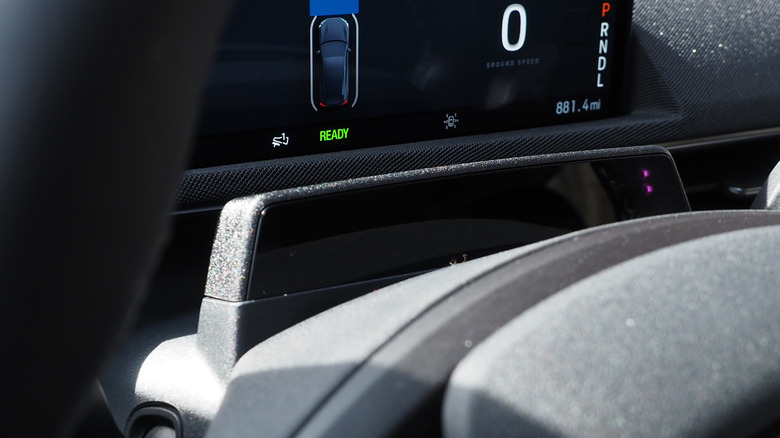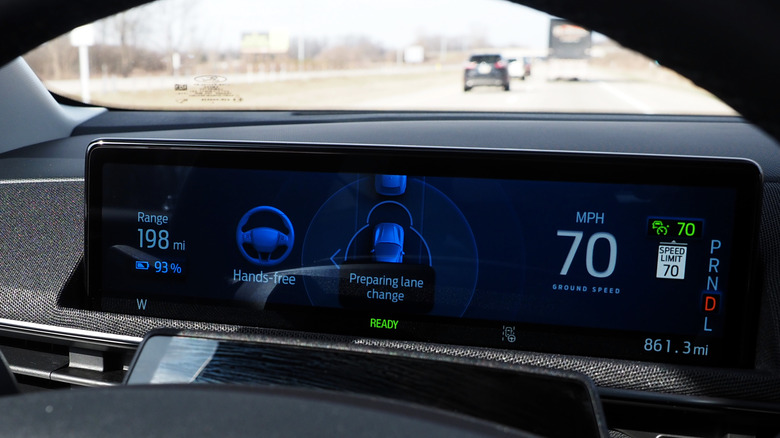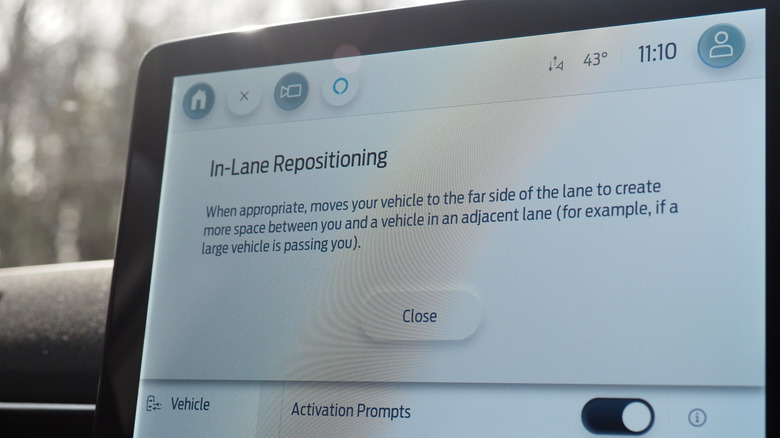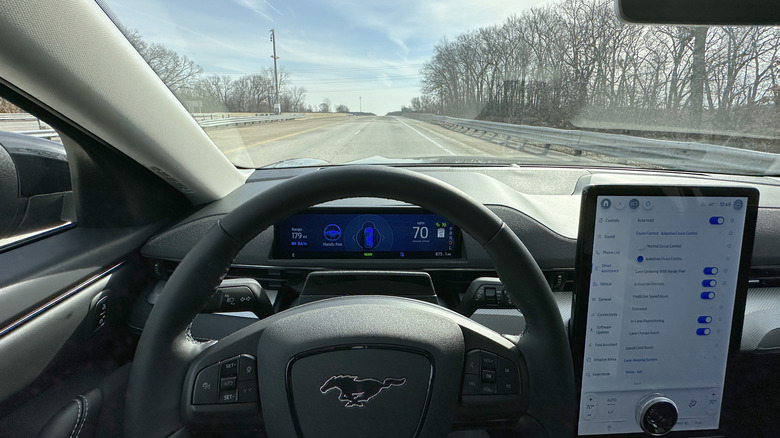Ford BlueCruise V1.2 Review: Hands-Off Highway Driving Gains Some Impressive New Skills
- Marked improvement in consistency since launch
- Hands-free driving is more relaxing
- Drives more like a sensible human now
- Rivals have more highway coverage
- Driver still needs to initiate lane-changes
- Auto speed adjustment can be aggressive
There are no fully-autonomous cars on sale today, but that's not to say you're completely on your own when it comes to driver assistance on a road trip. Advanced Level 2 systems like Ford BlueCruise can't take responsibility away from the person behind the wheel, but they can let them take their hands off that control. All in the name of a smoother and more rewarding drive.
The system launched in early 2022 on select models. With version 1.2, which debuts first on the 2023 Mustang Mach-E and will arrive on the Lincoln Corsair shortly, BlueCruise gains two significant talents. The first is Lane Change Assist, which allows BlueCruise to move the car between lanes with a tap of the indicator stalk. The second is Lane Repositioning, intended to build confidence in the system when you're surrounded by other — often larger — vehicles.
Back when I first tried BlueCruise — in the guise of its Lincoln ActiveGlide version, on the 2022 Navigator — I was generally hopeful, if a little underwhelmed in places. Ford's system arrived when GM's Super Cruise had already seen a number of updates, not least the two headline talents in this version 1.2. That, plus a number of unexpected deactivations in highway corners, left me expectant that Ford would refine the experience using over-the-air (OTA) updates.
Mustang Mach-E first, OTA later
BlueCruise v1.2 isn't being pushed out OTA yet — for the moment it's just on newly-built cars — though the automaker expects that will come later in 2023. Existing vehicles that have BlueCruise or ActiveGlide will get the latest update free, as long as they're within their original warranty period.
From behind the wheel of a 2023 Mustang Mach-E Select, though, I'd say it's worth the wait. While the headline features of v1.2 are useful, the system in general feels more stable and predictable than when I first tried it. For a start, there were none of the unexpected moments where BlueCruise decided it simply couldn't handle an otherwise-regular corner and threw control back to me in short order.
That's not to say it's perfect — and, given all of these systems are Level 2 despite being hands-off, there's no claim that you can stop paying attention — and highway lane shifts can still cause some fumbles. The change from two to three lanes, for example (or vice-versa), can cause BlueCruise issues at times, though the system is swift to resume once you're back to more predictable roads.
BlueCruise is watching you
As before, BlueCruise relies on a camera to make sure you're paying attention to the road. It's mounted just above the steering column, and — while you can't see them — there are infrared lights in there to allow the system to keep working even at night. It'll play nicely if you're wearing eyeglasses or sunglasses, too.
If you're on one of the roughly 130,000 miles of divided highways in the U.S. and Canada that Ford has pre-mapped, and you're deemed to be suitably alert, BlueCruise activates with a press of a button on the steering wheel. It'll automatically default to the highest level of automation it can: press it on an unmapped road and you'll get regular hands-on adaptive cruise control with lane-keeping assistance. If you're on a "Hands-Free Blue Zone," as Ford calls them, it'll bypass that and switch straight into hands-free mode.
Just how long you can look away depends on a number of factors, but generally after a few seconds of inattention you'll get an audio warning and a message displayed on-screen. There's an escalating series of beeps and visual alerts, and finally BlueCruise will deactivate completely if it deems the driver isn't playing their part.
Automated Lane Changing makes life much easier
BlueCruise's driver-facing interface is clean and makes good use of the Mustang Mach-E's relatively small cluster display. Engage the system, and a large steering wheel graphic appears; big text confirming you're in "Hands Free" mode underneath makes understanding whether you should be touching the wheel or not straightforward. Ford's graphics show whether there's a car ahead, though you don't get the birds-eye view of traffic that, say, Tesla's Autopilot UI includes.
Tap the turn signal — you don't have to press it all the way, and if you do, it won't auto-cancel once the lane change maneuver is complete — and a "Preparing lane change" message appears. A second or two later, assuming there's nothing in the adjacent lane, and BlueCruise moves across. Another graphic showing the direction of the maneuver appears while that's happening.
Ford's system feels like a sensible, fairly conservative driver from behind the wheel. There's a definite pause, as BlueCruise does the positioning math, and it's enough to miss narrower gaps that human drivers might feel confident taking advantage of in order to get out from behind a slow-moving truck. On the plus side, even if you're adjacent to said truck when you hit the turn signal, BlueCruise will generally wait for a gap to clear rather than instantly canceling the move.
A little more breathing room in the lane
That proximity to other traffic is the other big change in BlueCruise v1.2. In-Lane Repositioning aims to mimic the natural tendency of human drivers to shift over, giving more space to other — typically larger — vehicles when possible. It's as much a psychological thing as a practical one, if not more so: there's definitely a degree of discomfort when you're pinned in the middle of a lane while a hulking tractor-trailer looms to one side.
It's with those highway behemoths that you notice it in action most. Ford says that more extreme lane bias will prompt an on-screen message, explaining what's happening, but I never saw that appear in my test driving. That's despite the Mustang Mach-E shifting very close to the edge of the lane at points, away from the neighboring truck.
Smaller vehicles alongside lead to lesser offsets. In my experience, BlueCruise began to move over once the side sensors picked up on something in the adjacent lane: that meant I'd typically be already next to a trailer before the electric Mustang swung away.
A more cautious driver than most humans
Ford's other tweaks in BlueCruise v1.2 include Predictive Speed Assist, which promises to change the speed setting ahead of places where human drivers might typically slow down. That might be as you enter a curve, for example, or as the speed limit on a stretch of highway changes. It'll work in both hands-on and hands-off modes.
In practice, I noticed it most when BlueCruise suddenly overruled the speed I'd set it to. Certainly, I can't argue with being reminded that I was exceeding the current limit — which the system will still allow in hands-off mode — but suddenly cutting the target pace without warning felt like a problematic way of communicating it. That was particularly the case when it led to the Mustang Mach-E slowing aggressively while I had another vehicle close behind me.
For the most part, you can switch these settings on and off piecemeal. Lane Centering, Predictive Speed Assist, In-Lane Repositioning, and Lane Change Assist can all be enabled or disabled while the vehicle is in motion, through the Driver Assistance section of the settings pages.
Ford's rivals aren't waiting for it to catch up
While Ford has been working, its rivals haven't stood still, of course. We've seen hands-free highway assist systems arrive on cars from Nissan, for example. The all-electric Ariya can do the same lane- and speed-holding as BlueCruise, though currently lane maneuvers are completed manually.
The big challenge remains Super Cruise. That, for example, could already change lanes for you without the system deactivating; these days, it can automatically do so if you find yourself stuck behind slower traffic. GM's system can also be used in towing situations, and the automaker boasts more than 200,000 miles of compatible roads. Both Ford and GM are working on versions of their tech that can do unsupervised Level 3 highway driving, though for the moment that's still beyond either Super Cruise or BlueCruise.
In fact, only one system in the U.S. promises Level 3 functionality: Mercedes-Benz's Drive Pilot. Even then, it's only offered on a very small number of the automaker's most expensive cars; it'll only work at low speeds; and at the time of writing, it's limited to select highways in a single state, Nevada.
Ford BlueCruise Verdict
While hands-free Level 2 systems remain controversial, not least because of the potential for drivers to overestimate just how capable (and autonomous) they really are, I'm still a fan overall. BlueCruise feels far more mature and stable than when it did when I first tested the technology. Though my hands and feet may have been poised and ready, the only times I actually needed to get involved were when I intentionally triggered the attention monitoring system by making it appear like I was looking away.
Currently, BlueCruise is available on the Mustang Mach-E, the F-150, the F-150 Lightning, and the Ford Expedition. ActiveGlide is offered on the Lincoln Corsair and Navigator. That's not the full extent of Ford and Lincoln's line-ups, true, but it's a strong cross-section of them. Perhaps more notable, you don't have to buy the fanciest trim in order to add BlueCruise.
Despite all the hype around autonomous driving, the reality is that we're still a long way from cars that can operate themselves completely. And, while it's easy to consider systems like BlueCruise as a step toward such a degree of self-driving, in reality they're no more that than blind spot warnings are a replacement to looking over your shoulder, or that parking sensors mean you don't need to watch while you reverse. Trust the tech too enthusiastically, and you're going to get burned.
Nonetheless, highway driving is a chore, and I undoubtedly feel more comfortable at the end of it with a system like BlueCruise to support me. The challenge — as with most advanced driver assistance — is ensuring attention without nagging so aggressively that it's not worth having the tech turned on. For my taste, Ford's approach strikes that balance, and though BlueCruise v1.2 may not have quite the capabilities or the confidence of its most full-featured rivals yet, it's a good example of how OTA updates can progressively make a good system even better.







